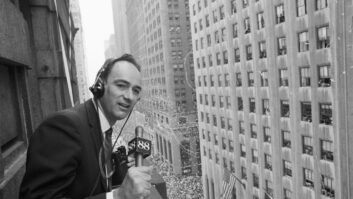Are you in the radio business or the entertainment and news business?

National Public Radio answered that question in 2014 with a new strategic plan that states, “To be relevant and fulfill its mission, public radio must create news and entertainment content that serves the needs of the broad American public and innovate on new platforms.”
Consistent with that vision, NPR launched a 10-minute daily podcast called “Up First” in April of 2017 to “use people’s morning time efficiently and get them up to speed on what they need to know for the day,” says NPR VP/News Sarah Gilbert. The growth in listenership has been quick, already garnering a million listeners a week.
Moments before “Up First” is distributed as a podcast, it airs as the first live segment of “Morning Edition,” and Gilbert says it’s “more fluid, a little more conversational, a little more accessible,” a feel that “infused the rest of the show and updated the sound of ‘Morning Edition.’”
Does a daily NPR morning podcast compete for listeners with NPR’s on-air product? Not really, says Gilbert. The average age of an “Up First” listener is 31, younger than most of NPR’s broadcast listeners.

“A large proportion of the [podcast] audience doesn’t experience public radio content in any other way. We’ve brought people into the NPR ecosystem who might not have found us otherwise. Once you’re here, you learn how many different exciting, trustworthy and credible things NPR can provide.”
The numbers support that theory. While NPR’s 42 podcasts are now reaching 20.4 million unique listeners monthly, Nielsen Audio ratings for programs like “Morning Edition” are maintaining peak levels, just under 38 million listeners each week.
NEW DAILY NEWS HABITS

Newspapers like the venerable New York Times have been forced to think about distributing their content on new platforms since the 1990s. Maybe that’s why they were the first major media outlet to jump into the morning news podcast category with “The Daily.”
“I had wanted to do a daily podcast for a long time,” says “The Daily” producer Theo Balcomb. “People would say, ‘That’s crazy! Podcasts are supposed to be evergreen. You put so much effort into it, you don’t want it to expire in six to eight hours.’ But I knew that there was a healthy appetite for morning news. You need for people make you a daily habit. That means you have to give them the news when and where they want it.”

Having worked for Maine Public Radio and New York’s WNYC(FM) previously, Balcomb’s résumé set the standard for the Times’ new audio staff, with eight people working on “The Daily” and several more on other audio projects.
“The people we hire are reporters and editors in their own right and also have strong audio backgrounds. We have a mix of folks, people who come from doing daily news, but also people who’ve come from documentary and long-form reporting. That’s kind of the magic of what we’ve made, combining those styles,” Balcomb explains.

Like NPR, ABC News has been producing podcasts for years. “But we only decided to create a daily news podcast last year after it became clear that podcast audience measurement was gaining traction with advertisers,” says Steve Jones, head of audio for ABC. Once they concluded there was a business opportunity, Jones and his team looked for ways to differentiate. “We thought a 20-minute, highly produced, daily podcast providing context and clarity on the top four or five stories a day would fill a need.”

ABC News’ “Start Here” gives the network’s star correspondents a new outlet to tell great stories.
“I’m asking the same questions I’d ask them at drinks after work,” says host Brad Mielke.
Of course, they also don’t need to set up a camera to talk to Brad. When Chief White House correspondent Jonathan Karl was in Singapore for President Trump’s summit with North Korea’s Kim Jon Un, “Jonathan calls us from a van taking reporters to the president’s press conference. He tells us, quietly, what question he’s going to ask. Then a few minutes later, President Trump calls on him. You just can’t get that type of access from most places.”
At “The Daily,” Balcomb encourages New York Times reporters to ask if they can tape interviews for possible use on the podcast. “Michael Schmidt and Emily Steel recorded an interview with Bill O’Reilly and captured amazing audio of him getting very upset and yelling at Emily and Mike. You would have never gotten that from a print story.”

Jones believes local news outlets should consider creating morning news podcasts also, “provided the content is truly local and unique.” In fact, the survival of long-established news brands may depend on it.
“Podcast listeners’ median age is 29 years old, while radio news/talk listeners are aged 60-plus,” says Jones. “By providing high-quality journalism produced in a conversational and lively audio format, we’re making ABC News more valuable to a younger audience that wants credible information.”
Veteran radio programmer Dave Beasing is speaking at both The Conclave and Podcast Movement this summer to broadcasters who, like him, are expanding their careers into podcasting. He can be reached at his new venture, SoundThatBrands.com.












